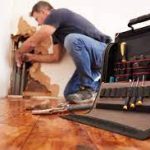There is nothing as overwhelming and complex a problem as a home that’s hit by a water damage. The spillage on the floor, dripping eaves, musty stench and pipes leaking left, right, centre—you really feel underprepared for this mess. However, water damage restoration is no big deal, provided you choose the right water damage restoration method for your home.
Any water damage clean-up needs to be assessed for its extent, source of water whether clean or contaminated, and how long the damage has remained in the house. Water damage classes denote increasingly higher levels of water/moisture penetration:
- Class 1: Minimal damage
A section of a room has absorbed minor amount of moisture - Class 2: Moderate damage
Extended damage to entire rooms, carpeting and walls by absorbing moisture - Class 3: High damage
The water has penetrated and saturated most of the area including walls and potentially the ceiling. Structural damage imminent - Class 4: Specialised drying
Owing to the nature of material like concrete, hardwood, stone, etc., normal drying will not work, therefore the need for specialized drying.
Depending on how intense the issue is, you may need to hire professionals for water damage restoration services.
- Air Drying
If you’ve just spilled some water in a room by accident, it would call for a simple mop-up using a mop or towels. The amount of water here would be ideally very less, and you can just do it yourself easily. To prevent dampness, you should air dry the area. Open up the ventilation systems and windows, turn on the fans to speed up the process of evaporation.
The drying may be accelerated by the use of room heaters or air-movers.
- Dehumidification
In water damage, time is of prime importance, so the speedier the drying, the better your home is. If you want to completely eliminate the risk of pesky mold and mildew, you want to help the drying a bit with dehumidification. Often, water damage restoration services professionals include dehumidification as part of their clean up routine.
The older equipment take up to 4-5 days to remove moisture from air, whereas Low Grain Refrigerant (LGR) dehumidifiers can remove up to 16 gallons of water per day from the air. This is highly efficient, as it gets the work done in about half the time for older equipment.
- Desiccant dehumidifiers
Dehumidification equipment are often noisy and do not respect the indoor air quality requirements. A restoration technician will use a desiccant dehumidifier that contains silica gel, a material that absorbs moisture from the air.
A very high degree of dryness is achieved by this method; moreover, customers prefer the desiccant dehumidifiers because they are light-weight and quieter in operation.
- Intra-Wall Drying
Water damage makes dry wall look soggy and cracked at the plaster level. Water gats seeped within the crevices and cracks of walls, often requiring the damaged drywall to be removed and replaced. This method is relatively new, that involves eliminating moisture and drying the inside of walls without removing drywall. In the process, baseboards are taken away, and small holes are drilled at the bottom through the walls. Then, Air is injected into the cavity behind the drywall, thus reducing drying time radically. Intra-wall drying is appropriate when the origin of water damage is the spaces above the room being treated.
- Extraction
A method suitable for sucking away water from fabrics like carpets and upholstery, extraction is a simple but effective method. In the method, competent water damage clean-up experts use industrial grade power vacuums and other equipment, procedures and techniques to pull away water from the base through the carpet fibres. The method does not offer complete drying, as the underlying pad remains slightly moist to the touch, but not wet. Other drying techniques are used in conjoint for full drying. You don’t need to untack your carpets for low shrinkage; it’s low-cost and fast.
So next time you happen to find yourself in a puddle, just think what exactly you need to do, and don’t hesitate to contact the best professionals in water damage remediation in your area!

















